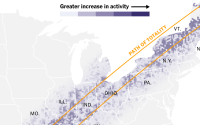Wildfires Burn for Days in Southern U.S. States
Wildfires caused by drought, warmer-than-normal temperatures and, in a few cases, possibly arson have been ablaze for days in several Southern states. The threat has led officials to enact burn bans and to stop issuing safe-burn permits.
November is the peak month of the fire season across the country, but certain areas, including parts of the Southeast, are expected to be at an “above-normal” risk, according to the National Interagency Fire Center. Mississippi, for example, was one of eight states that reported large fires to the National Fire Service on Friday. Drought and below-normal precipitation have been some of the contributing factors, according to the center.
While the fires in Mississippi have largely been contained, firefighters in Virginia and elsewhere are still working to put out the flames over large chunks of their territories.
“The Southern fire season has become more and more a fire year,” Shayne Martin, the national spokesman for the Forest Service at the U.S. Department of Agriculture, said in a statement. “Fires are burning longer, hotter and create more destruction in recent years.”
Mr. Martin said that the wildfires in the South were particularly alarming because the region has “three of the top four states with the most homes near wild lands, thereby creating more risk to human health and property.”
Virginia
Extremely dry conditions and high winds were feeding the wildfires in Virginia, spurring Gov. Glenn Youngkin to issue a state of emergency that went into effect on Monday, and was to remain active for 30 days.
Governor Youngkin said officials were concerned about two fires in particular, the Quaker Run fire in Madison County and the Tuggles Gap fire in Patrick County.
The Quaker Run fire had burned about 2,800 acres of private, state and federal lands by Tuesday morning, according to the National Park Service. Around 670 of those acres were in Shenandoah National Park, where officials imposed a fire ban, effective Tuesday. The Virginia National Guard sent two Black Hawk helicopters to pour water onto the fire.
Two homes and an outbuilding were destroyed by the Poplar Drive fire in Henderson County, which has spread to more than 400 acres from 175 acres since Saturday. Just 5 percent of the fire had been contained by Monday, and officials were still investigating the cause.
Two other fires remained active in the state, officials said: the Collett Ridge fire in Cherokee County and the East Fork fire in Jackson County.
Officials have banned all open burning in North Carolina and canceled burning permits in 14 counties in the western part of the state because of the threat of wildfires stemming from severe drought.
“Because dry conditions are expected to continue, this burn ban is necessary to reduce the risk of fires starting and spreading quickly,” Steve Troxler, the state’s agriculture commissioner, said in a statement on Sunday. “Our top priority is always to protect lives, property and forestland across the state.”
Kentucky
There were 61 active fires in Kentucky on Tuesday, burning through an estimated 8,800 acres, said John Mura, a spokesman for the Kentucky Energy and Environment Cabinet.
Many of the fires had been burning for several days, but they escalated over the weekend, Mr. Mura said. The fires have been concentrated in the eastern and southeastern parts of the state.
Six different fires erupted over the weekend in Harlan County, in southeast Kentucky. Dan Mosley, the county’s judge-executive, declared a state of emergency. Officials said they suspected that arson could have caused the fires in the area around the town of Smith; other fires in the county were believed to have started after people tried to burn debris, and those blazes grew out of control.
It was unclear when the fires would be put out, but there was a small chance of precipitation and cooler temperatures that could help toward the end of the week, Mr. Mura said.
Tennessee
Officials fought more than 30 fires that had burned more than 200 acres of privately owned woodland in Tennessee by Monday, according to the state’s Division of Forestry. At least seven fires were still active on Tuesday, with the bulk clustered in the central and western parts of the state, according to a map provided by the Division of Forestry. A number of other fires were designated as contained or controlled, meaning that control lines had been established around the fires.
The Division of Forestry stopped issuing safe debris burn permits in most counties, and officials issued a burn ban in Morgan County on Monday, which is in the eastern part of the state.
Drought fueled the fires and officials noted that rain was anticipated to return later in the week, with the central area of the state expected to see at least a half inch of precipitation.


